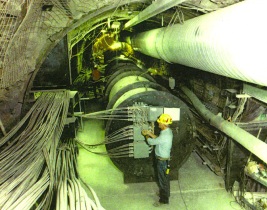In a tunnel, hundreds of feet underground, scientists are conducting heat experiments that will provide more understanding of how a geologic repository in Yucca Mountain would fare over the centuries. They are analyzing the thermal, mechanical, hydrologic, and chemical effects of the heat on the mountain using three different kinds of tests: the large block test, the single heater test, and the drift scale test. The largest of the thermal tests, the drift scale test, began in December of 1997. The rock under study for this test will be heated for four years. Then scientists will gradually bring the temperature down to simulate the declining temperature of the radioactive waste, a process that will take another four years. In the early stages of the experiment, DOE scientists predicted that the heat may actually work to tighten the fractures in the rock. However, the heat did force water out of the rock and into the tunnel, raising concerns that the heat may actually facilitate water movement and canister deterioration. Project scientists believe that the heat may cause an “umbrella effect,” which DOE defines as a dry barrier around the waste tunnels where the heat has forced the water out. However, definitive results will only be available after the eight years the drift scale thermal testing is scheduled to take, the same year construction on a repository is set to begin. |
 As radioactive elements decay, they give off extreme amounts of heat. Scientists at Yucca Mountain are now simulating the effects of the heat emitted by high-level nuclear waste on the volcanic tuff where it would be buried if a permanent repository for nuclear waste is approved.
The thousands of metric tons of radioactive waste will generate temperatures anticipated to be over 400 degrees Fahrenheit. Over time, as the spent fuel and radioactive wastes gradually decay, the temperature will drop.
As radioactive elements decay, they give off extreme amounts of heat. Scientists at Yucca Mountain are now simulating the effects of the heat emitted by high-level nuclear waste on the volcanic tuff where it would be buried if a permanent repository for nuclear waste is approved.
The thousands of metric tons of radioactive waste will generate temperatures anticipated to be over 400 degrees Fahrenheit. Over time, as the spent fuel and radioactive wastes gradually decay, the temperature will drop.